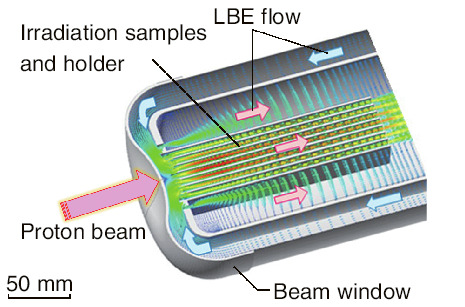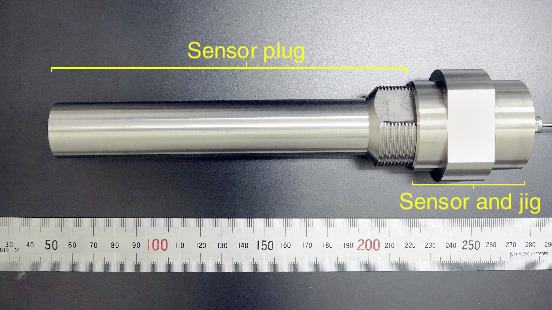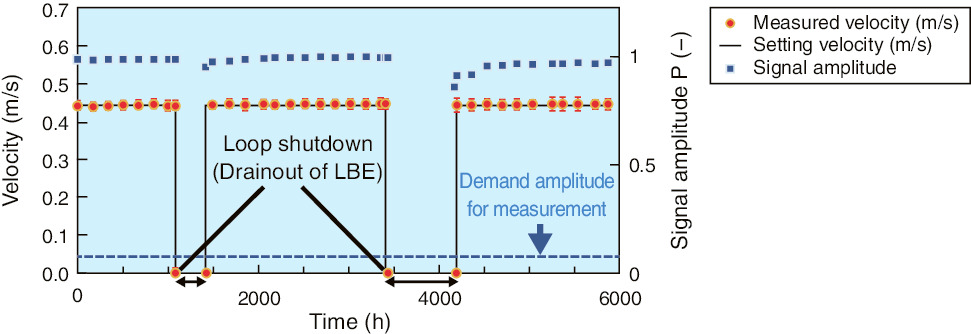
Fig.4-8 Schematic of a lead-bismuth-eutectic (LBE) target vessel

Fig.4-9 Exterior of ultrasonic sensor for LBE-flowrate measurement

Fig.4-10 Result of the LBE-flow-measurement test
Spent nuclear fuel contains long-lived high-level radioactive materials that are highly toxic to humans and the environment. We have performed various R&D activities towards an accelerator-driven system (ADS) for transmuting long-lived nuclides into short-lived or stable ones using neutrons generated in a spallation target. In an ADS, the spallation target provides neutrons generated via spallation reactions induced by bombarding intense high-energy-proton beams onto a heavy material such as lead. Construction of an ADS target test facility (TEF-T) falls within our scope as a step preceding construction of a demonstrative ADS for performing a post-irradiation-examination program of several candidate ADS materials such as T91 and type 316SS. A lead-bismuth-eutectic (LBE) alloy spallation target (Fig.4-8) is installed in the TEF-T and irradiated by a 400-MeV, 250-kW pulsed proton beam. The flowrate of LBE should be controlled with an accuracy less than 10% because it affects the safety of the LBE target and the temperature of the irradiation field. Since LBE is strongly corrosive to materials under high-temperature environment, it is too difficult to measure the flowrate of LBE stably over a long period. To overcome this issue, we focused on the ultrasonic transparency of opaque metallic materials and developed an ultrasonic-flowmeter based on the measurement technology for a sodium-cooled fast reactor. This technology employed the propagation-time difference of an ultrasonic burst signal to derive a mean velocity along a signal path. Since this method does not require suspended particles, it is a more practical instrument that can prevent contamination of an LBE. The resultant flowmeter provided stable output under the flowing-LBE environment for long operating periods.
Lead zirconate titanate (PZT) is a typical piezoelectric element for emitting an ultrasonic signal. Since its maximum applicable temperature is about 365 ℃, it is difficult to use PZT at the operational temperature of an LBE target (350–450 ℃). Furthermore, PZT is weak in a radiation environment; therefore, we developed an ultrasonic sensor (Fig.4-9) using lithium niobate (LiNbO3). The permittivity of LiNbO3 is smaller by one order of magnitude or more than that of PZT, while it has a high temperature resistance of more than 1000 ℃ and a high radiation resistance. As a countermeasure against a small permittivity, a liquid-immersion plug ensuring wettability with LBE was provided on the front surface of the sensor to solve the typical problem that inhibited signal propagation at the solid–liquid boundary. We also applied a linear signal path to realize efficient signal exchange, achieving a reception signal with an intensity of about 50% of that of the transmission signal.
As a result of application tests performed in an experimental LBE loop shown in Fig.4-10, we succeeded in monitoring the LBE flowrate with a satisfactory stability (error: 3% or less) under the operating conditions assumed for the TEF-T target (flow velocity: 0.37 m/s; operation time: about 4500 h). We decided to apply the ultrasonic flowmeter to TEF-T. In the future, we will acquire more data with the present flowmeter by performing simulation tests such as coolant-flow-reduction events to further improve the safety of LBE target.